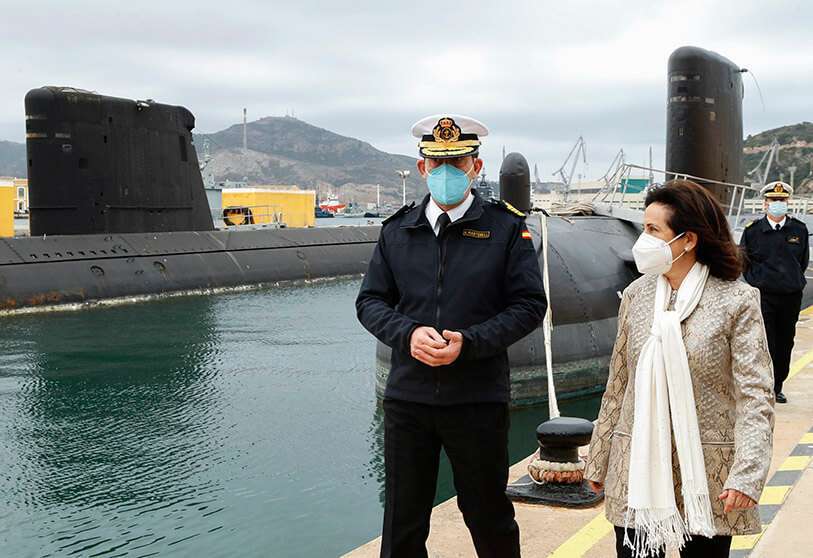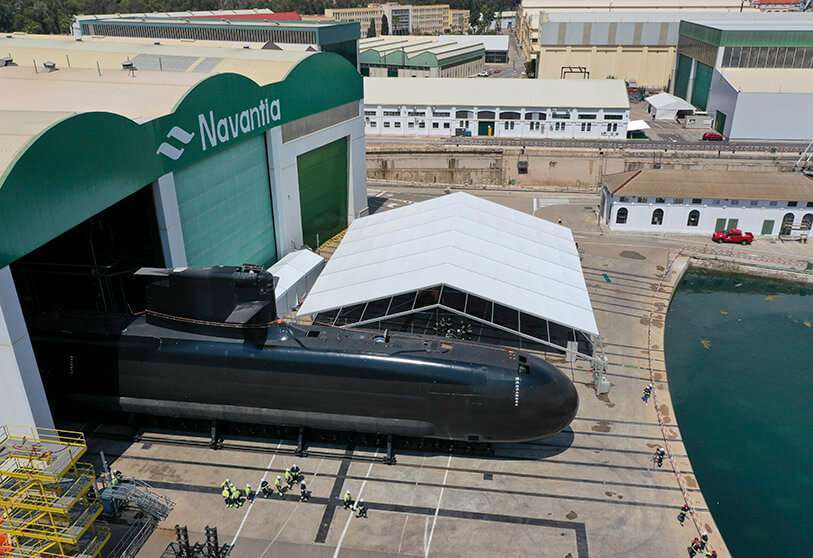Navantia presents the world's most advanced non-nuclear submarine in society

At the Cartagena factory of the Navantia shipyard, details are being finalised to officially present the S-81 "Isaac Peral", which is destined to be the Spanish Navy's first new generation non-nuclear propulsion submarine, to the world.
The ceremony will take place on Thursday morning, April 22nd, and will be presided over by King Felipe VI, who will be accompanied by Queen Leticia and her two daughters, the Infanta Sofía and Leonor, the Princess of Asturias. Princess Leonor will be the godmother of the new warship, which has been named in homage to the Spanish sailor who invented the torpedo submarine in the late 19th century.
The S-81 is the first of the four submersibles of the S-80 class, whose conception, design, development and construction have been carried out entirely in Spain. They have been designed as an instrument of national sovereignty, a deterrence vector and to carry out anti-submarine warfare missions, actions against surface ships, protection of naval forces and offensive mining.

For Navantia, the S-80s represent an enormous technological leap forward, since in addition to its status as main contractor it is also the technical design authority, a role it is exercising for the first time and which places the national shipbuilding industry among the small group of countries to which only Germany, China, South Korea, the United States, France, Japan, the United Kingdom, Russia and Sweden belong.
The restrictions for the COVID-19 have limited the presence of authorities, among which will be the Minister of Defence, Margarita Robles; the President of the Region of Murcia, Fernando López Miras; the Chief of Defence Staff, Admiral Teodoro López Calderón; the Chief of Staff of the Navy, Admiral Antonio Martorell; and the recently appointed president of the public shipyard, Ricardo Domínguez. The ceremony, which Navantia describes as "launching", will take place "dry", without the submersible touching the water.

The "Isaac Peral" will make contact with the Mediterranean in the next few days by means of a floodable floating dock. This will be followed by an extensive in-port testing campaign, to be followed by surface navigation sea trials, which are scheduled to begin in early 2022. The S-81's activities will continue with the submergence campaign until it reaches a maximum depth of around 300 metres. Official delivery to the Navy is scheduled for the beginning of 2023 and entry into service in the second half of that year.
The S-80 programme is the greatest technological challenge facing the naval sector of the national defence industry. To make the new family of submarines a reality, the Cartagena factory has been certified in accordance with the PECAL 2310 standard governing the aerospace defence industry. Having identified a weight deviation in the structure in 2012, Navantia used the systems engineering methodology that the US National Aeronautics and Space Administration (NASA) applies to the development of satellites, space capsules and launchers to redefine the project, which was approved by the Ministry of Defence in 2016.

With a budget of 3,907 million euros, the S-80 class submarines are the largest and heaviest ever built in Spain, while having a very low acoustic and magnetic signature. Their displacement when submerged is around 3,000 tonnes, almost double that of the S-74 "Tramontana", the last Spanish submarine built in the 20th century, launched in 1985 - 36 years ago - and the only one of the Navy's Submarine Flotilla still in service.
The S-81 is 80.8 metres long and has a maximum diameter or beam of 7.3 metres, 20% longer and 7% wider than the S-74. A total of 180 different systems can be accommodated inside the ship, providing a high degree of automation. Most of them are interconnected by wiring totalling 60 kilometres, a length that makes it possible to circle the ship nearly 700 times.
As for on-board weapons systems, navy sources have confirmed that the "Isaac Peral" and its siblings will be equipped with German Atlas DM2A4 heavy torpedoes and Boeing UGM-84L Harpoon Block II missiles in the so-called "encapsulated" version. The Harpoons have a range of around 150 kilometres and are fired from the six forward torpedo tubes while the submarine is submerged. At the moment, "there are no plans for Raytheon UGM-109 Tomahawk land-attack cruise missiles". However, engineers have set up "a space and weight reserve to incorporate the Tomahawk command and fire control system", which has a range of more than 2,000 kilometres.

The Navy has already decided on the names of the remaining three ships in the series, all of which are dedicated to Spanish seafarers who were pioneers of submarine navigation. The three are at different stages of the manufacturing process in the extensive workshops of the Cartagena factory, Navantia's headquarters specialising in submarine construction.
The second in the series is the S-82 "Narciso Monturiol", on which work is already underway on the hydrodynamic outer hull, the structure that is visible and whose shapes are designed to facilitate the boat's movement, both on the surface and underwater. On the S-83 "Cosme García", the inner structure of the hull has been completed, in the shape of a cylinder and made of high-strength steel, which in some key areas uses titanium, essential materials to withstand the high pressures at great depths. The last of the series is the S-84 "Mateo García de los Reyes", where workers and engineers are currently installing the inner hull frames.

The S-80 class will be hybrid and will have the capacity to sail with three propulsion modes: diesel-electric, electric with batteries and the so-called Air Independent Propulsion (AIP), which provides great stealth in immersion. Essentially, AIP technology consists of reforming hydrogen from bioethanol, introducing it into a fuel cell with the addition of oxygen and obtaining a continuous current to power the submarine's batteries anaerobically.
However, the S-81 will not yet have the AIP option, as its development by Navantia-Abengoa was completed when the submarine's inner hull was already closed. The first operational AIP will be integrated in the S-83 ˗which is scheduled to be launched in 2024˗ and a year later in the S-84. The AIP will be installed on the S-81 and on the S-82 during its first major hulling, when it will undergo a complete overhaul of its on-board equipment. The companies JALVASUB and the Cidaut Foundation are working on the so-called MEDUSA project, which is developing a new, entirely national fuel cell to be installed on the four submarines.

Other relevant equipment on board are the combat system, the platform control system and the integrated communications system, which allow the crew to be reduced to just 32 sailors - half the crew of the S-70s - and the possibility of taking on board eight additional passengers. However, the high level of automation of the S-80 will allow such a small crew to be able to operate navigation, propulsion, power generation, masts and periscopes even remotely.









